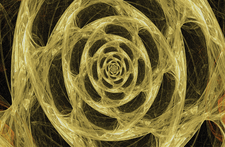Evolution of a Passion Project
Distro Walk – Knoppix

Knoppix, a portable operating system and rescue disk, continues to evolve.
For over 20 years, Knoppix has been the premier portable operating system and rescue disk for Linux users. Although its packages are drawn from the Debian repositories, and contributors add to its hardware support, the bulk of the work on the distribution is done by German electrical engineer Klaus Knopper (Figure 1), an independent consultant and instructor at the Kaiserslautern University of Applied Sciences. Over the years, Knoppix's hardware support has increased, features have been added and dropped, and its original purposes have been joined by ADRIANE (Audio Desktop Reference Implementation and Networking Environment), a desktop designed for the sight impaired with input from Klaus's wife, Adriane Knopper (Figure 2). All of which shows how this passion project is evolving with the times and is as important as ever.
"When I started studying electrical engineering in the late '80s," Klaus Knopper says, "my plan was to build electric cars and solar power plants. Apparently, this vision was just a little too early, so my interests turned more towards networking software and the possibilities that appeared with the Internet." At the time, free software was how Unix-like systems were taught, with exercises done with the GNU shell and compiler collection, using the GNU/Linux, BSD, and Hurd kernels. Knopper was among the students who founded a Unix working group, which eventually went on to organize the LinuxTag expo.
A few years later, Knopper encountered the Linuxcare Rescue CD, an 18MB business-card-sized CD with the Linux kernel and a command-line rescue tool. Knopper recalls, "I thought that a full CD-sized operating system with all the applications I use frequently, including a graphical desktop, data forensics, and TeX and other favorites would be extremely practical for travelling without a computer, using publicly available computers while still being able to use my personal software collection without installation."
[...]
Buy this article as PDF
(incl. VAT)
Buy Linux Magazine
Subscribe to our Linux Newsletters
Find Linux and Open Source Jobs
Subscribe to our ADMIN Newsletters
Support Our Work
Linux Magazine content is made possible with support from readers like you. Please consider contributing when you’ve found an article to be beneficial.

News
-
Zorin OS 18 Hits over a Million Downloads
If you doubt Linux isn't gaining popularity, you only have to look at Zorin OS's download numbers.
-
TUXEDO Computers Scraps Snapdragon X1E-Based Laptop
Due to issues with a Snapdragon CPU, TUXEDO Computers has cancelled its plans to release a laptop based on this elite hardware.
-
Debian Unleashes Debian Libre Live
Debian Libre Live keeps your machine free of proprietary software.
-
Valve Announces Pending Release of Steam Machine
Shout it to the heavens: Steam Machine, powered by Linux, is set to arrive in 2026.
-
Happy Birthday, ADMIN Magazine!
ADMIN is celebrating its 15th anniversary with issue #90.
-
Another Linux Malware Discovered
Russian hackers use Hyper-V to hide malware within Linux virtual machines.
-
TUXEDO Computers Announces a New InfinityBook
TUXEDO Computers is at it again with a new InfinityBook that will meet your professional and gaming needs.
-
SUSE Dives into the Agentic AI Pool
SUSE becomes the first open source company to adopt agentic AI with SUSE Enterprise Linux 16.
-
Linux Now Runs Most Windows Games
The latest data shows that nearly 90 percent of Windows games can be played on Linux.
-
Fedora 43 Has Finally Landed
The Fedora Linux developers have announced their latest release, Fedora 43.

